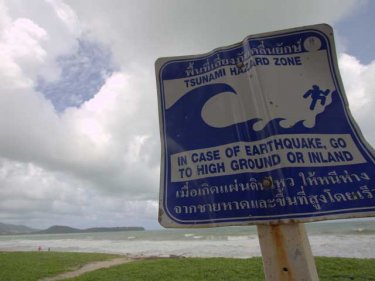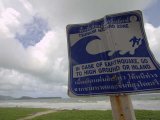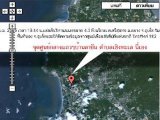''By taking steps today to reduce their vulnerability to earthquakes and tsunamis, people and communities can reduce the chance of future tragedies,'' says the observatory.
Seismologists from the observatory report today on the ''extraordinary earthquakes in the Indian Ocean offshore of Aceh'' last Wednesday.
The magnitude 8.6 and 8.2 earthquakes produced an evacuation on Phuket and in other Andaman tourism centres as well as in all those places around the region that were affected by the 2004 tsunami.
Because these earthquakes shifted the sea floor side to side rather than up and down, no tsunami was produced on Wednesday.
This time it was a lucky break, literally, for Phuket and the region. A total of 5400 residents and tourists died in Thailand in the 2004 tsunami, among more than 220,000 victims around the Indian Ocean.
''This earthquake may be the largest strike-slip (side-to-side) earthquake ever recorded in the world,'' the observatory's report notes.
''The April 11 earthquakes may make future earthquakes near Sumatra more likely to happen sometime in the coming decades.
''Research shows that there still remains potential for large earthquakes and tsunamis in Aceh and West Sumatra provinces and the neighboring areas sometime in the coming decades.
''Science cannot predict the day or year that an earthquake will happen, but does show which areas face high hazard
''Analysis and interpretation of the data from April 11 will help us better understand future earthquake hazard in the region.''
Earthquakes interact. The large Sumatran earthquakes in 2004, 2005, and 2007 triggered one another and may have triggered the April 11 earthquakes.
Seismologists at the observatory will now also be looking at Monday's 4.3 earthquake, with its epicentre reported on Phuket, and whether this has a connection to previous larger earthquakes.
The observatory says it was also '' exceptional'' that Wednesday's 8.6 earthquake triggered an 8.2 earthquake only two hours later, 200 kilometres to the southwest.
''This second earthquake apparently shows a simpler rupture, mostly on a north-northeast-trending strike-slip fault,'' today's report says.
''To probe deeply into these questions, EOS scientists have a unique tool: the 50 continuous GPS stations of the SuGAr network installed in Sumatra and the outer islands.
''They are busy unravelling the huge amount of data already accumulated on the many large Sumatran earthquakes in the past decade.
''As the April 11 measurements start to flow in, preliminary data analysis indeed suggests interaction between the strike-slip faults on the deep seafloor and the megathrust: the April 11 earthquake has pushed back the leading edge of the Sunda/Eurasian plate about 20 centimetres north-eastward.
''This research is critical for understanding earthquake and tsunami hazard. With this information, society can take many steps to reduce vulnerability to these hazards, from the individual and community to national and international levels.''
For those who are concerned to know precisely where the epicentre of Monday's Phuket shake was, here's what the Earth Observatory of Singapore had to say:
Regarding your location question, the epicentre "dot" on the map can be a little misleading: the position is an estimate based on analysis of seismograms; however, every estimate includes some uncertainty due to inherent limitations of data coverage and analysis.
The USGS page reports a position uncertainty of about 24 km, meaning that the epicentre could have been anywhere within a circle with a radius of about 24 km centred on the dot on the map:
http://earthquake.usgs.gov/earthquakes/recenteqsww/Quakes/usc00094qk.php
The epicentre location reported by the Thai Meteorological Department is just about 24 km from the USGS position. The Thai department don't report an uncertainty. (There is uncertainty, they just don't happen to report how much on this summary page.)
http://www.tmd.go.th/en/earthquake_report.php
So, from the scientific point of view, these two reported positions are roughtly consistent with one another, within the uncertainties of measurements and analysis of earthquakes. In other words, there is not a significant difference between the earthquake positions reported by the USGS and by the Thai Meteorological Department.














Thank you Phuketwan for the follow up.
Posted by Lena on April 18, 2012 14:40